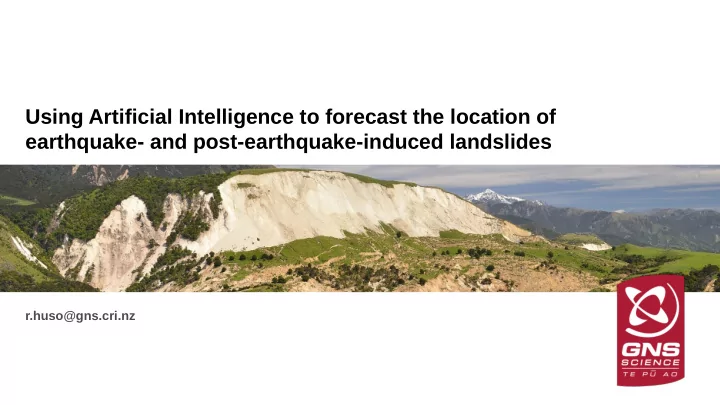

Using Artificial Intelligence to forecast the location of earthquake- and post-earthquake-induced landslides r.huso@gns.cri.nz GNS Science
Contents • Development of an Earthquake-Induced Landslide (EIL) forecast tool for NZ • Model Structure and Training GNS Science
AI versus Log Regression AI model Log Regression model 1 Log Re gres sion - K aikoura trained AI model trained on Inangahua and Murchison EQ landslide • 0.8 datasets, then used to forecast Kaikoura EQ landslides AI - Murchis on a nd Ina ng ahua trained True positive rate Log Regression model trained on Kaikoura EQ and landslides 0.6 • ROC curve only showing 0.4 model AI model statistically preforms well in forecasting Kaikoura EQ • 0.2 performance landslides 0 0 0.2 0.4 0.6 0.8 1 False positive rate GNS Science
Landslides Variables investigated (12) • Variables with statistical significance: • Slope angle – Faults Distance to surface fault rupture – Elevation – Geology – PGA or PGV – LSR: Local Slope Relief – GNS Science
Data Difficulties ● Data discontinuities and one-hot encoding – Natural ordinal relationship between the categories? ● ‘cold’, warm’, and ‘hot’ – Not suitable for one-hot encoding ● Quaternary gravel, debris, sand ● Neogene siltstone, sandstone ● Cretaceous conglomerate, igneous rocks, limestone, mudstone, siltstone ● Early Cretaceous igneous rocks ● Paleogene igneous rocks, limestone, limestone GNS Science
Data Difficulties (2) ● Data scales – Distance (~100,000 m) – Elevation (~2000 m) – LSR (~200) – PGA (~100) – Slope (~90) – GeolCode (1, 2, 3, 4, 5) GNS Science
Data discontinuities GroupInputData CaptureDataLimits Config.json ScaleInputData HyperCubeSmoothing GNS Science
Structure Difficulties ● Model structure – Number of hidden layers – Number of nodes per layer – Amount of “Dropout” GNS Science
Structure Difficulties HyperparameterOpt HyperparameterOpt OptimalEpochs Config.json GNS Science
Model Training and Testing ● Train the model ● Apply to Out Of Sample data (if any) ● Rank the input features ● Show charts GNS Science
Model Training and Testing TrainModel TrainModel ApplyModel FeatureRanking Config.json ShowCharts GNS Science
Model Charts – Confusion Matrix GNS Science
Model Charts – Receiver Operating Characteristic GNS Science
Model Charts – Receiver Operating Characteristic GNS Science
Summary • Rapid forecasts of landslide probability and impacts in near-real time (5-7 minutes) after an event would help to focus such response efforts • Several discrete steps are required to produce a useful model that can be applied when an earthquake event happens GNS Science
Questions r.huso@gns.cri.nz GNS Science
Recommend
More recommend